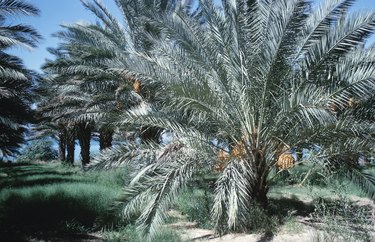
False smut, also known as graphiola leaf spot, is caused by a fungus that feeds on plant tissue. The fungus presents as small, rough black spots covering older leaves and stems. Date palms are the types most often affected by false smut, but almost any palm is susceptible during long periods of high humidity, as these conditions favor fungal spread. According to the University of Florida, infections of false smut are rarely damaging beyond affecting the cosmetic value of the plant.
Step 1
Water only in the morning so moisture can dry before cooler night temperatures set in. Additionally, avoid getting leaves wet when you water.
Video of the Day
Step 2
Remove infected leaves to reduce the chance of spreading the disease.
Step 3
Thin plantings to improve airflow if false smut is a persistent problem. Overcrowding prevents air from drying foliage and increases humidity. Palms in these conditions are at continued risk, and some may need to be removed to improve the overall health of the landscape.
Step 4
Apply a foliar fungicide containing copper hydroxide if cultural practices don't help clear up the infection. Always read and follow the manufacturer's directions carefully when using a fungicide.
Warning
The University of Florida cautions against removing too many diseased leaves if your palm is already suffering from a nutrient deficiency. Removing leaves on a nutrient-starved palm could do more damage than would simply allowing the fungus to run its course.
Video of the Day